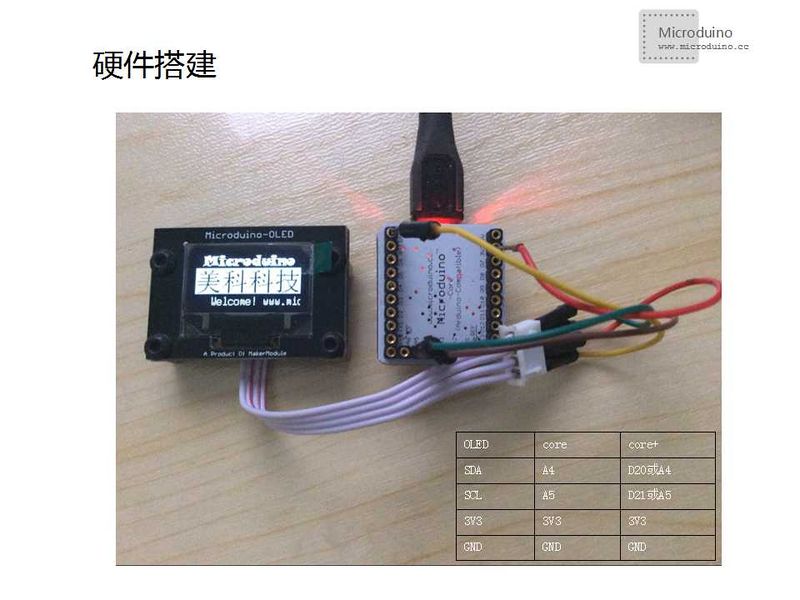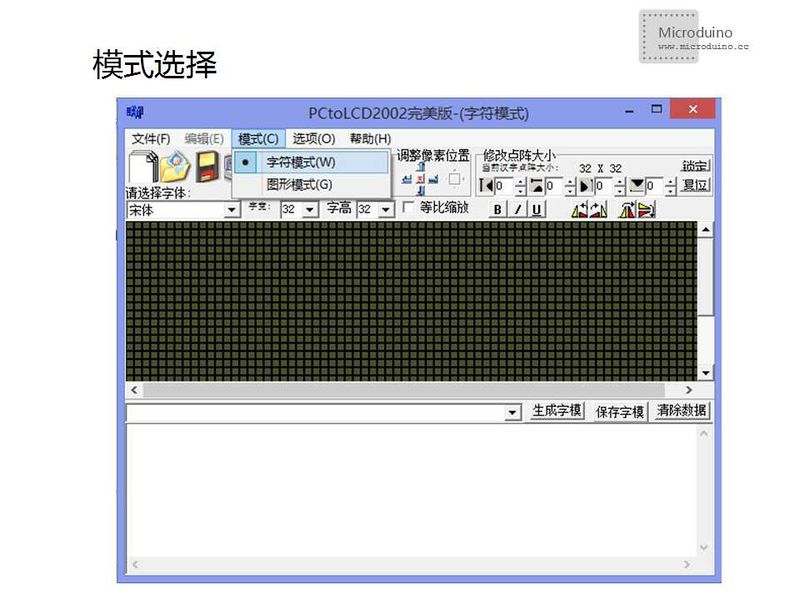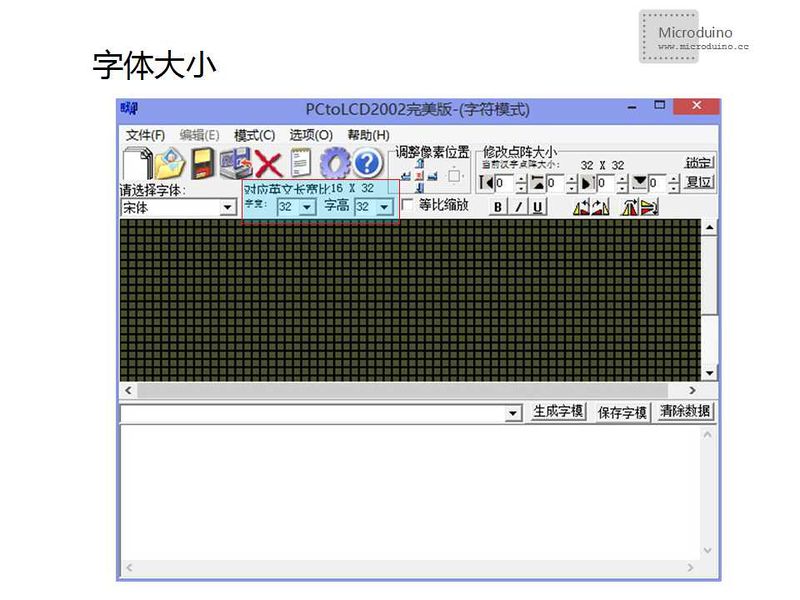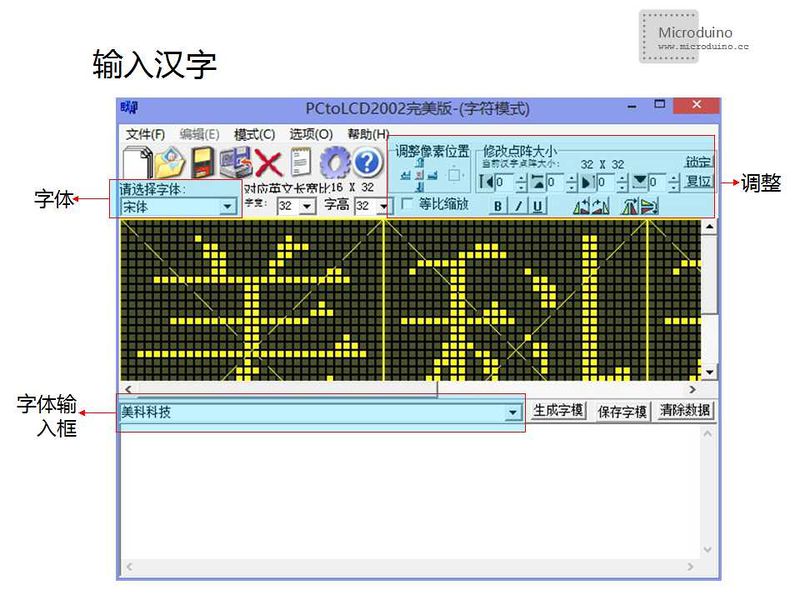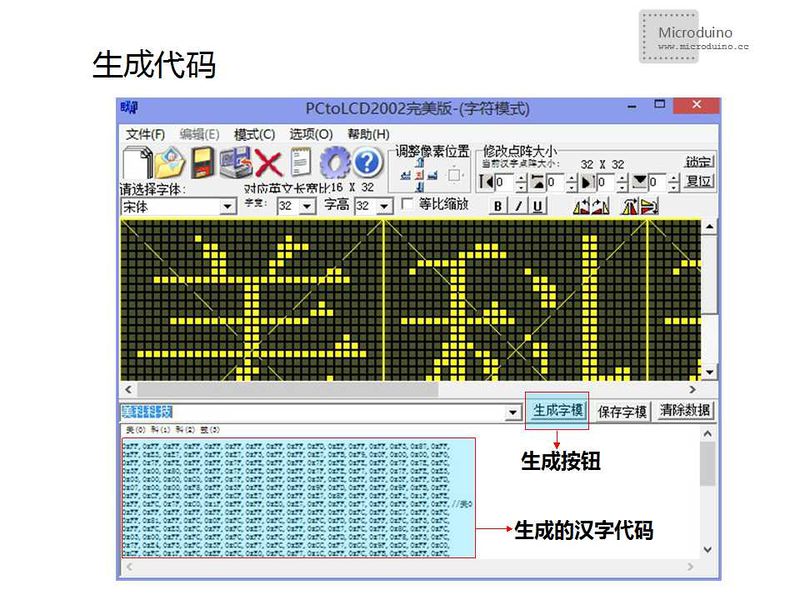Objective
Learn the Microduino OLED and master how to use the library to derive the OLED.
Equipment
Microduino-Oled is a 0.96 inch 12864 OLED display module based on SSD1306. It uses I2C interface, and 3.3V power. The pixel is 128 * 64 (128 columns * 64 rows).
- Other equipments:
- OLED adapter cable one
- DuPont line four
- USB cable one
IIC communication
| OLED |
Core |
Core+
|
| SDA |
A4 |
D20 or A4
|
| SCL |
A5 |
D21 or A5
|
| 3V3 |
3V3 |
3V3
|
| GND |
GND |
GND
|
Prepare work
- 【U8glib librarygoogle download 】
- Put the downloaded library into the libraries folder of the Arduino IDE;
- Open the example program. If you have opened the Arduino IDE, need to close firstly, then open the example program from the u8glib library:
- Connect the OLED to circuit according to IIC connection method.
Program
Download program:
https://github.com/Microduino/Microduino_Tutorials/tree/master/Microduino_Advanced/Microduino_OLED
Experiment 1
- Display character, including the specific character and the character changed according to data.
Grammar:
- The first line display "*_*Microduino*_*";
- The second line display "Time:";
- The third line display time calculated by function mills(), use the ms as unit, and map into the second unit, only keep two decimal.
- Grammar:
- u8g.setFont(XXX)uses to set font, no default font, must be defined.
- u8g.setPrintPos(X,Y) uses to set he position of the specified character,X represents the horizontal position coordinate, Y represents longitudinal coordinates. The Y value can't be 0 in top line, and the value should be greater than the height of the font.
- u8g.print(XXX)uses to display character, static characters need to add " ", no need for change data;
- u8g.drawStr(X, Y,XXX) uses to display specified character, can't display changing data;
- u8g.setRot180()uses to font rotation, rotate character from 180 to 90, 270. The default value is 0;
- Change font and coordinates need to add fonts and coordinate function in front of the display function;
- When change font, need to find the font library in file u8g.h from U8glib\utility folder.
Experiment 2
Open "OLED_Paint" example program, select board type and use the serial to download.
The experiment to realize how to draw a straight line, a solid, hollow, solid rectangular, hollow rectangular, apex angle bending rectangular, the system timing simulate the pointer of second hand.
- Grammar:
- u8g.drawLine(X,Y,M,N) uses to draw a straight line;
- X: starting horizontal position coordinates, Y: the starting point of the longitudinal coordinates, M: end horizontal position coordinates, N: the end of the longitudinal coordinate.
- u8g.drawDisc(X,Y,D) uses to draw a solid:
- X: horizontal coordinates, Y: longitudinal coordinate, D: diameter;
- u8g.drawCircle(X,Y,D) uses to draw a hollow:
- X: horizontal coordinates, Y: longitudinal coordinate, D: diameter;
- u8g.drawFrame(X,Y,I,W) uses to draw a hollow rectangular:
- X: horizontal coordinates, Y: longitudinal coordinate, I: length, W: wide;
- u8g.drawBox(X,Y,I,W) uses to draw a solid rectangular;
- X: horizontal coordinates, Y: longitudinal coordinate, I: long, W: wide
- u8g.drawRFrame(X,Y,I,W,B) uses to draw a apex angle bending rectangular;
- X: horizontal coordinates, Y: longitudinal coordinate, I: long, W: wide
Experiment 3
- Display Chinese characters, images and dynamic text:
- Display character using library. The images and Chinese characters need to modulo then to print.
Modulo software:File:PCtolCD.zip
- Take the Chinese character as example:
- Make Chinese character modulo code:
Step 1: Open the modulo software, select the mode "Character mode";
Step 2: Set font size as 32*32;
Step 3: Input chinese character, you can choose font;
Step 4: Set modulo format;
Step 5: Set the code;
Step 6: Use the code to replace the character.
Grammar:
- u8g.drawXBMP( X, Y, I, W, XXXX);
- X: horizontal coordinates, Y: longitudinal coordinate, I: long, W: wide, XXXX: Chinese character code name of the array.
Video
|
